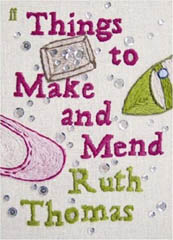Things to Make and Mend
 An acclaimed short story writer, Ruth Thomas has written a tight and precise debut novel about adolescence, nostalgia and acceptance. Things to Make and Mend follows the lives of two women, once best friends, who are haunted by their past. Thomas uses embroidery as a metaphor for life’s patchwork quilt.
An acclaimed short story writer, Ruth Thomas has written a tight and precise debut novel about adolescence, nostalgia and acceptance. Things to Make and Mend follows the lives of two women, once best friends, who are haunted by their past. Thomas uses embroidery as a metaphor for life’s patchwork quilt.
Chapter headings are named after embroidery techniques and labels, including Knotted, Zigzag, Twisted Chain and the peculiarly resonant Four Legged Knot. Life is like a complex piece of embroidery, but with rather more humour and sadness. Quotes from the Brownie Guide Handbook head certain chapters, offering domestic wisdom, such as: ‘understand the importance of labels’. Thomas’s characters struggle to do just that. They are teenage mothers, heartless lotharios and Needlewoman – ‘homelier sister of Wonderwoman’.
Sally Tuttle works in an alterations shop in her home town of East Grimstead. In her spare time she embroiders prolifically, using an abundance of glittering sequins. She is the kind of woman who walks into haberdashery departments, ‘ to kneel at the altar of stranded cottons’. It is at this point on page one that a significant demographic of the female population go ‘aaahh’. How many women, from all walks of life have embroidered in anger or relaxation, practicing economy or simply wanting to get away from men? It is a domestic pursuit developed through the centuries. But today, it is a peculiarly charged word: is it just a domestic hobby, a possible career or a cause for public celebration?
Sally, working class and insecure, wins an award for her naïve and sparkling work and as a result is invited to speak at an Edinburgh embroidery conference. An outsider, she is intimidated. Speaking before her is a macho academic called Jeremy Bowes, who lectures on courtly love. He tells Rowena Cresswell, an academic, that the conference is ‘a glorified women’s sewing circle’.
Rowena is an ex-friend of Sally, who bumps into Jeremy at conferences around the world. Thomas adroitly draws these links between two middle-aged women, who haven’t spoken since they were fifteen and a half, when a devastating event changed their lives and destroyed their friendship. Rowena travels to Edinburgh at the same time as Sally, because her son is about to move to America and she needs to say goodbye. Faced with this loss, Rowena is nostalgic for the deep friendship she had with Sally and is drawn back into the past.
Memories of the women’s teenage years are knotted into the story of their middle age. Slang, timetables and hours in front of a mirror vividly create a school setting, whilst embroidery, spinster teachers and sexual naivety firmly place the scenes in the 1960s. Both girls attend St. Hilary’s, which has ‘a peculiar preoccupation with the gentle arts’. They are ‘like sisters’, inseparable, each equally scathing about needlework, which they are taught by the appropriately named ‘Miss Button’. However, as with so much of Thomas’ language, these words vibrate. It is not just that the simple joke works: there is something small and tight and unyielding about Miss Button, despite her twenty-four years and evident sex appeal.
In an effective twist towards the end of the book, Sally finds that she has more in common with Miss Button that she realises. ‘The best part of three decades stretches and breaks, like a dividing cell’, when Miss Button and a middle-aged Sally meet unexpectedly. In any case, the stretching had been insistent and a breakage inevitable. The adolescent past of the two girls has shaped – and still haunts – both women. Sally is commissioned by members of the clergy to sew a biblical scene, something ‘everyday’. She chooses to depict Mary and Martha, the Lazarus sisters who make such different choices. The two embroidered women have worn and lop-sided faces, which do not please the church, but project Sally’s much more personal engagement with reality.
Male characters can be slightly insubstantial. They pass through; ripping the fabric of hopes and dreams, trailing pulled strands behind. Thomas paints with a fine brush, capturing confusion and weakness, not obviously apportioning blame. She shows how creation, destruction and repair co-exist. Relationships form, new life is created, relationships break: it is a simple story, but archetypal. It can also be amusing. Sally attends an ill-fated diner with Jeremy and a conference organiser called Nora. The flirtation between the pair, with Sally an unwelcome third, is rich with satire, suggestion and sadness. How can she not see through him? Sally asks herself. Although she may have a ‘gossamer-light hold on reality’, as past partners have suggested, she has, at least, lost her naivety about love.
Thomas’s technique involves lists, italics and brackets, fragments woven into the narrative, capturing the dragging slowness of a bad school day (‘LUNCH highlighted in glorious pink), or vacillating thoughts about daughters or different types of fabric. Thomas’s strength lies in accuracy, in her eye for detail. She can convey a web of emotion by stitching small things together.
The conclusion is predictable but necessary, the last stitches that make the work complete. Realism rather than drama is Thomas’s aim. She sketches awkward attempts at conversation, set against the backdrop of Sally’s wildly fantastic embroidery. Mary and Martha peer down, one with a squint. It is a pleasing tableau.
This is a deft first novel and Thomas’s quick turns of phrase and understated wit make it a page-turner. But inevitably, the ‘aaahh’ demographic will respond with greater empathy and for them it will be much more. They will see in it themselves: the quiet story of make-and-mend women.
© Hannah Adcock

Comments